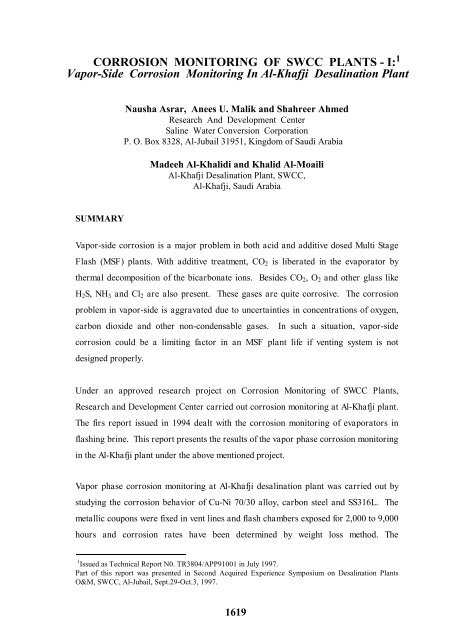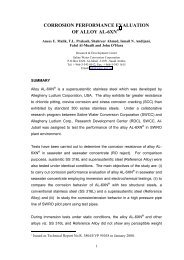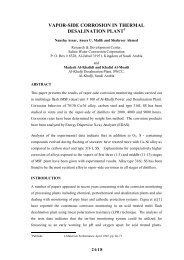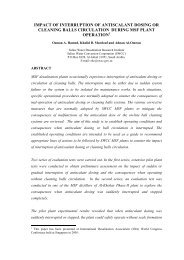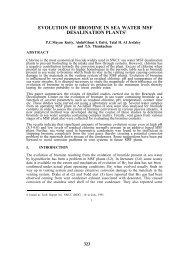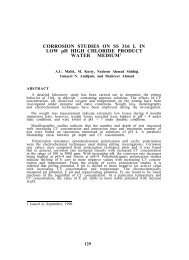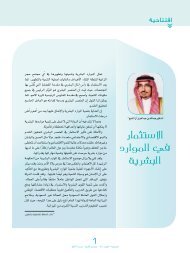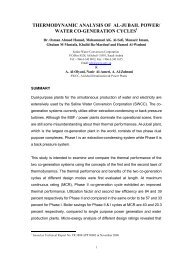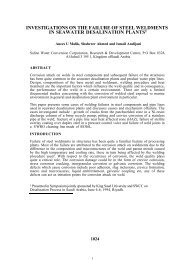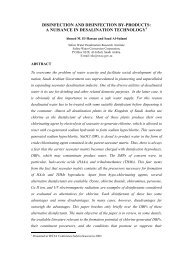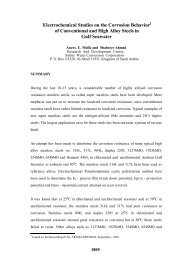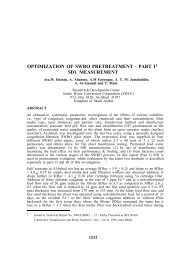CORROSION MONITORING OF SWCC PLANTS - I:1 Vapor-Side ...
CORROSION MONITORING OF SWCC PLANTS - I:1 Vapor-Side ...
CORROSION MONITORING OF SWCC PLANTS - I:1 Vapor-Side ...
Create successful ePaper yourself
Turn your PDF publications into a flip-book with our unique Google optimized e-Paper software.
<strong>CORROSION</strong> <strong>MONITORING</strong> <strong>OF</strong> <strong>SWCC</strong> <strong>PLANTS</strong> - I: 1<br />
<strong>Vapor</strong>-<strong>Side</strong> Corrosion Monitoring In Al-Khafji Desalination Plant<br />
Nausha Asrar, Anees U. Malik and Shahreer Ahmed<br />
Research And Development Center<br />
Saline Water Conversion Corporation<br />
P. O. Box 8328, Al-Jubail 31951, Kingdom of Saudi Arabia<br />
Madeeh Al-Khalidi and Khalid Al-Moaili<br />
Al-Khafji Desalination Plant, <strong>SWCC</strong>,<br />
Al-Khafji, Saudi Arabia<br />
SUMMARY<br />
<strong>Vapor</strong>-side corrosion is a major problem in both acid and additive dosed Multi Stage<br />
Flash (MSF) plants. With additive treatment, CO 2 is liberated in the evaporator by<br />
thermal decomposition of the bicarbonate ions. Besides CO 2 , O 2 and other glass like<br />
H 2 S, NH 3 and Cl 2 are also present. These gases are quite corrosive. The corrosion<br />
problem in vapor-side is aggravated due to uncertainties in concentrations of oxygen,<br />
carbon dioxide and other non-condensable gases. In such a situation, vapor-side<br />
corrosion could be a limiting factor in an MSF plant life if venting system is not<br />
designed properly.<br />
Under an approved research project on Corrosion Monitoring of <strong>SWCC</strong> Plants,<br />
Research and Development Center carried out corrosion monitoring at Al-Khafji plant.<br />
The firs report issued in 1994 dealt with the corrosion monitoring of evaporators in<br />
flashing brine. This report presents the results of the vapor phase corrosion monitoring<br />
in the Al-Khafji plant under the above mentioned project.<br />
<strong>Vapor</strong> phase corrosion monitoring at Al-Khafji desalination plant was carried out by<br />
studying the corrosion behavior of Cu-Ni 70/30 alloy, carbon steel and SS316L. The<br />
metallic coupons were fixed in vent lines and flash chambers exposed for 2,000 to 9,000<br />
hours and corrosion rates have been determined by weight loss method. The<br />
1 Issued as Technical Report N0. TR3804/APP91001 in July 1997.<br />
Part of this report was presented in Second Acquired Experience Symposium on Desalination Plants<br />
O&M, <strong>SWCC</strong>, Al-Jubail, Sept.29-Oct.3, 1997.<br />
1619
morphology of the scales and composition of the corrosion products were determined by<br />
scanning electron microscopy (SEM) and energy dispersive X-ray analysis (EDAX).<br />
The results of the vapor phase corrosion monitoring study indicate that cupronickel<br />
alloys are significantly corroded in vent line by S-containing compounds including H 2 S,<br />
whereas carbon steel appears to be less prone to corrosion due to sulfur. Stainless steel<br />
has been found to be most resistant to vapor side corrosion in flash chambers or vent<br />
lines. The higher corrosion rates in the middle stages (11-13) have been explained on<br />
the basis of combined effect of temperature, air in-leakage and accumulation of gases<br />
due to cascading.<br />
1. INTRODUCTION<br />
<strong>SWCC</strong> manages seawater desalination plants with a total capacity of 520 MIGD of<br />
potable water to meet the drinking water requirements of 70% population of the<br />
Kingdom. Some new plants are under construction to increase the capacity to 800<br />
MIGD [<strong>SWCC</strong> Annual Report 1994]. Failures of components may result in<br />
unscheduled shutdown of the plant and consequently in the reduced production of water.<br />
Multistage flash (MSF) evaporation and reverse osmosis (RO) are the two main<br />
techniques used for producing potable water from seawater. The former is<br />
predominantly employed for the production of desalinated water. An MSF plant is<br />
much more prone to corrosion due to its operation at higher temperatures. Corrosion<br />
monitoring of the component/material in an operating desalination plant is a profoundly<br />
important task because it provides a wealth of information about the condition of plant<br />
in terms of construction materials, components and operational parameters. All these<br />
informations can be useful in evaluating the performance and behavior of materials and<br />
efficiency of the plant.<br />
A number of papers appeared in recent years concerning with the corrosion monitoring<br />
of processing plants including chemical, petrochemical and desalination plants and also<br />
dealing with monitoring of pipe lines and cathodic protection systems. Cigna et al.<br />
[1985] have reported the continuous corrosion monitoring in an acid treated multi flash<br />
1620
desalination plant using linear polarization resistance (LPR) technique. The analysis of<br />
the tests data indicates that the on-line monitoring system could be utilized for<br />
foreseeing as an early warning for pH and oxygen upset for acid treated plants.<br />
Accordingly, the technique could be used to control oxygen level in brine and noncondensable<br />
carbon dioxide which are important parameters for efficient operation of<br />
the plant. Oldfield and Todd [1979] have studied theoretically the effect of oxygen<br />
content, flow rate and temperature on the corrosion of carbon steel, stainless steel 316 L<br />
and 90/10 cupronickel in seawater over the range of conditions likely to be met in a<br />
multi-stage flash distillation plant. The corrosion rate data from this study were found<br />
to be higher than the measured values presumably because of scale depositions. Some<br />
of the conclusions from this study are summarized in Table 1. Sato and Hamada [1969]<br />
stated that alkaline scale could be prevented in heat exchanger tubes and other parts of<br />
flash evaporators by keeping the brine pH below 7.5. CaSO 4 scales were not observed at<br />
twice concentrated seawater brine up to a temperature of 115 o C. Corrosion tests of a<br />
range of materials including welded joints were carried out by placing in the flash<br />
chambers of three MSF plants [Hodgkiess et. al. 1983]. The results of the plant studies<br />
have correlated well with laboratory studies indicating that accelerated corrosion of the<br />
welds in carbon steel plates is associated with relatively high oxygen concentration in<br />
the brine. It was observed that corrosion problems were not serious with properly-made<br />
welds between stainless steel plates. Nordin [1983] carried out a study in an air ejector<br />
system of an MSF plant using 316L and 904L stainless steel pipes, whilst 316L failed by<br />
SCC, the later grade appeared to be quite resistant to corrosion. Failure of SS316L was<br />
attributed to the presence of bromine in the venting gases. In a recent paper [Narain<br />
1992], corrosion problems experienced in a low temperature (max. distillation<br />
temperature : 59 o C) desalination plant, based on multi-effect evaporation supplemented<br />
with ejector vapor compression process are described. It has been found that severe<br />
crevice corrosion occurred at the joints of titanium heat exchanger tubes and 904L tube<br />
sheets; cathodic protection using iron anodes appeared to be effective in preventing<br />
corrosion. Aluminium brass tubes suffered impingement corrosion and were replaced<br />
with 90/10 Cu-Ni tubes. Erosion-Corrosion of 90/10 Cu-Ni ejector condensers was<br />
prevented by replacement with alloy 254 SMO.<br />
1621
A survey of some important work carried out on corrosion monitoring in MSF plant as<br />
cited above indicates that the corrosion of construction materials in flash chambers and<br />
water boxes has been studied adequately by a number of investigators. However, the<br />
major problem in both acid and additive MSF plants is vapor-side corrosion. While in<br />
acid dosed plants, almost all the CO 2 is removed by the decarbonator, CO 2 is present<br />
along with O 2 as non-condensable gases in additive treatment plants. Other gases like<br />
H 2 S, NH 3 , Br 2 and Cl 2 may also present in significant concentrations and could be<br />
responsible for corrosion attack.<br />
Oldfield and Todd [1987] studied vapor side corrosion in an MSF plant. It was<br />
concluded that in acid dosed plants and probably also in additive plants the vapor-side<br />
corrosion is caused primarily by the presence of oxygen, this was coming not from the<br />
deaerated brine but from air-in-leakage into the evaporator. The results of studies on the<br />
corrosion behavior of stainless steels were reported [Saricemen et. al. 1990]. In air<br />
ejector system of an MSF plant using stainless steel 316L and 304 L steel pipes, while<br />
316L failed by SCC, the latter grade appeared to be quite resistant to corrosion. Failure<br />
of SS 316L steel was attributed to the presence of Br 2 in vent gases [Oldfield et al.<br />
1981]. Lee, Oldfield and Todd [1983] reported failure of 316L components in the<br />
venting system of MSF in Qatar due to bromine. The presence of ammonia in seawater<br />
above the normal background level is necessary for this to occur. After 25 years of<br />
operation, Abu Dhabi desalination plant experienced corrosion problems in its 23 large<br />
distillation units [Al Sum et. al. 1994]. The deterioration of the protective oxide film<br />
appeared to he the main cause of the problem which could be solved by improving the<br />
efficiency of the deaerator and the venting system. In other case [Mc Gregor et. al.<br />
1995], a group of 24 MSF distillers experienced failure of tubes in the first few high<br />
temperature stages after 50,000 to 100,000 hours of operation. It was concluded that the<br />
problem of tube failure was due to the presence of pockets of CO 2 gas near the tubes,<br />
which redissolves in distillate to form an aggressive solution. The installation of an<br />
auxiliary vent to reduce the size of the gas pocket allowed a significant increase in<br />
distillate pH and reduction in dissolved copper.<br />
The selection of corrosion monitoring system for plant is considered on the basis of<br />
parameters controlling the performance of the plant. Environment (corroding or non-<br />
1622
corroding or both), materials of construction and design are the important factors to be<br />
considered. A wide variety of methods or techniques are available for carrying out<br />
corrosion monitoring. The choice of a particular corrosion monitoring technique<br />
depends upon the type of information required during monitoring which include : defect<br />
parameter to be measured, access to the stream, equipment reliability and response.<br />
Electrochemical, analytical and nondestructive (ND) testings are the methodologies<br />
used for corrosion monitoring. The different techniques available for corrosion<br />
monitoring include : linear polarization resistance (LPR) [Fontana 1986, Ijsseling<br />
1986], electrical resistance [Schollen 1976], corrosion coupon testing, analytical<br />
radiography [Berger 1989], ultrasonic, eddy current, acoustic emission [Pollock 1984],<br />
infra red imaging, remote visual testing (RVT), thin layer activation (TLA) [Asher et.<br />
al. 1987] and field signature method [Strommen et. al. 1993]. Due to limitations on the<br />
amount of information which one can obtain from any single technique, simultaneous<br />
use of more than one technique is always preferable in order to obtain meaningful data<br />
on corrosion process.<br />
Corrosion monitoring in <strong>SWCC</strong> seawater desalination and power plants is an important<br />
project placed in the first priority list of the <strong>SWCC</strong> R&D tasks. As a first phase of the<br />
project, the corrosion monitoring of Al-Khafji Phase II desalination was undertaken in<br />
January 1992. A technical report <strong>SWCC</strong> (RDC) - 34 was submitted in July 1994<br />
containing the results of 18 months monitoring studies carried out in the flash chambers<br />
(in the brine flashing zone) and water boxes in desal unit # 100 and # 200. In November<br />
1995, the progress of the project was internally reviewed and it was decided to complete<br />
the studies by the end of 1996. Whilst the corrosion monitoring studies carried out up to<br />
1995 were almost entirely concentrated on monitoring in flashing brine, the work<br />
carried out during the year 1996 was entirely focused on Corrosion Monitoring in vapor<br />
phase. This report presents the results of vapor side corrosion monitoring of evaporator<br />
and vent line in unit # 100 of Al-Khafji desalination plant phase II.<br />
In the following section, a summary of the results of corrosion monitoring of flash<br />
chambers and water boxes is given, the results are discussed in detail in aforementioned<br />
report submitted in July 1994.<br />
Corrosion Monitoring of Flashing Brine Zone<br />
1623
The corrosion monitoring of flash chambers (in the brine flashing zone) and water boxes<br />
in desal unit # 100 and 200 was carried out in lower (4, 6-9), middle (10-12) and last<br />
(19) stages of evaporator and 5-6, 7-8, 9-10 and 11-12 stages of water box. Weight loss<br />
and polarization resistance measurements were used to determine corrosion rates.<br />
Stainless retractable corrosion coupon holders carrying carbon steel or cupronickel<br />
samples were fixed in flash chambers or water boxes for weight loss measurements.<br />
Electro-chemical polarization probes fixed with carbon steel or cupronickel electrodes<br />
were used to measure corrosion rates at regular time intervals. For weight loss<br />
measurements in flash chambers or water boxes, the exposure time varied from 45 days<br />
to 130 days.<br />
Analysis of corrosion data from electrochemical studies and weight loss measurements<br />
indicated that by and large, overall corrosion rates of carbon steel and cupronickel in<br />
flashing brine and water box, respectively, were well within allowable range.<br />
Modification in the present methodology for improving the levels of accuracy and<br />
reliability and its implications on plant operation are discussed.<br />
<strong>Vapor</strong> Phase Corrosion Monitoring of Al-Khafji MSF Desalination Plant<br />
<strong>SWCC</strong> Al-Khafji MSF desalination plant was commissioned in 1985. It has a designed<br />
capacity of producing 22727 m 3 /d (5 MIGD). There are 2 desal units (# 100 and # 200),<br />
each unit has 22 stages. The material information and construction particulars for the<br />
evaporator and the water boxes are provided in Table 2. This plant is an additive dosed<br />
plant and in this plant no chemical scavenging of oxygen of make-up is carried out.<br />
<strong>Vapor</strong>-side corrosion monitoring for this project was carried out in unit # 100 of this<br />
plant.<br />
2. OBJECTIVES<br />
Following are the objectives of the project on Corrosion Monitoring in Al-Khafji<br />
Desalination Plant:<br />
1624
(a) To determine the corrosion rates of constructional materials in flashing brine<br />
at different locations by using weight loss/coupon method.<br />
(b) To carry out on-line corrosion monitoring of the flash chambers by<br />
electrochemical method using Liner Polarization Resistance (LPR) probes.<br />
(c) To determine corrosion rate in vapor phase region of the evaporators and<br />
vents by fixing coupons and retractable coupons holders.<br />
The objectives under (a) and (b) had already been achieved and the results of the studies<br />
were incorporated in the technical report - <strong>SWCC</strong> (RDC) -34 issued in July 1994. This<br />
report includes the results of the studies carried out to achieve the above mentioned<br />
objective (c).<br />
3. EXPERIMENTAL<br />
3.1 Materials<br />
Commercially available carbon steel (0.3% C), SS316L stainless steel and 70/30 Cu-Ni<br />
alloy were used for corrosion monitoring.<br />
3.2 Technique<br />
Weight loss coupon technique was used for corrosion rate measurements following<br />
ASTM standards for Laboratory Immersion Corrosion Testing of Metals. (G31-72,<br />
reapproved 1-90) and Conducting Corrosion Coupon Test in Plant Equipment (G4-84).<br />
<strong>Vapor</strong> phase corrosion monitoring was done by fixing coupons in the venting line and<br />
flash chambers. The operational parameters of the plant were closely monitored, and<br />
any variation in the parameters reported during operation was taken into account.<br />
Following is the brief description of the technique and procedure involved.<br />
The weight loss technique is used so as to enable the corrosion rate measurements to be<br />
done without disturbing the plant operation. It has the advantage that the corrosion<br />
which has actually occurred can be observed on the sample. Moreover, this technique<br />
allows a visual examination, physical measurements and the chemical analysis of the<br />
1625
corrosion products. Corrosion coupons can be mounted in different configurations to<br />
study different types of corrosion mechanisms, such as crevice corrosion, galvanic<br />
attack and stress corrosion. Coupons, which are the test specimens of the material of<br />
interest, are carefully cleaned, weighed and measured before being assembled on the<br />
corrosion test retractable probes. During assembly, two coupons are arranged so that<br />
they are electrically insulated from the probe material so as to avoid galvanic attack.<br />
After a prescribed period of exposure, the corrosion probe is disassembled and the<br />
corroded coupons are chemically cleaned, weighed and corrosion rate is determined.<br />
The corrosion rate is calculated from the weight loss, time of exposure and original<br />
exposed surface area of the material by the following formula [Fontana, 1987].<br />
where :<br />
MPY =<br />
Mils Per Year<br />
W = Weight loss, mg<br />
A = Area of specimen, in 2<br />
MPY = 534 W<br />
AtD<br />
t = Exposure time, hr<br />
D = Density of specimen, g/cm 3<br />
In brine immersion zone, the coupon test method could be used successfully by using<br />
large surface area coupons. The most serious problem encountered in immersion zone<br />
is the high probability of scale formation. The scales can be adherent to metal which<br />
give an extra protection to the metal or could be non-adherent which could lead to<br />
initiate under-deposit corrosion. The difficult problem in calculation of corrosion rate<br />
of immersed coupon is the determination of actual surface area due to the scale<br />
formation and time parameters of this process.<br />
During coupon testing, the coupon could be mounted inside the flash chamber at<br />
different locations with different angles. The coupon should be insulated from flash<br />
chamber materials, fastener and holder materials by using any non-conductive material.<br />
3.3 Methodology<br />
1626
Coupons of carbon steel, AISI 316 L and 70 Cu-30 Ni were fixed above the demisters in<br />
different stages of evaporator and with the help of the retractable coupon holders in the<br />
vent lines of different stages. Figure 1 shows the photo of cascading vent line of unit #<br />
100 at Al-Khafji plants where the coupons were fixed. Coupon locations and exposure<br />
periods in flash chambers and vent lines and their arrangement is shown schematically<br />
in Figures 2. and 3<br />
Coupon Locations<br />
Exposure Period<br />
1. Vent line stages # 3, 8, 13, 17 and 22 2000 and 4000 hr.<br />
2. Evaporator stages # 1, 4, 10, 14 and 18 9000 hr.<br />
The results of corrosion monitoring in vent line show comparatively high corrosion rates<br />
in central stage # 13. In order to investigate this behavior in more detail, coupons of<br />
carbon steel and cupronickel were also fixed in stages # 9, 10, 11 and 12 for 2,000 hrs<br />
exposure. The arrangement of coupon placement is shown schematically in Fig. 4.<br />
Coupons fixed in the vapor-side of the evaporator were taken out after 9,000 hrs., while<br />
coupons fixed in vent lines were taken out after 2,000 and 4,000 hrs of exposure.<br />
4. RESULTS AND DISCUSSION<br />
<strong>Vapor</strong> side corrosion monitoring in vent line and flash chambers of MSF desalination<br />
plant, Al-Khafji was carried out by exposing the carbon steel, cupronickel and AISI 316<br />
samples. The choice of 70-30 cuopronickel was mainly due to its ready availability and<br />
its application in last stages of the evaporator. Moreover, chemical reactivity wise there<br />
is no significant difference between 90/10 and 70/30 cupronickel. The specimens were<br />
exposed for 2,000 and 4,000 hr in vent line and 9,000 hrs. above the flashing zone of<br />
evaporator stages.<br />
Figures 5 to 8 show photographs of carbon steel, AISI 316L and 70/30 Cu-Ni alloy,<br />
respectively, exposed to vapor in flash chambers of desalination unit # 100. Heavy<br />
corrosion is observed in carbon steel specimens. It can be markedly observed that the<br />
1627
carbon steel coupons exposed in early stages (# 4) formed black scales which are very<br />
adherent while in the later stages (# 10 onwards) the scales formed are rust colored and<br />
loose. After removal of scales, pitting can be seen on the surface of alloys (Fig. 9), the<br />
pitting is more extensive in later stages. Considerable amount of corrosion products<br />
were observed on cupronickel alloy exposed in stage # 4 while very little corrosion was<br />
found on cupronickel alloy coupons exposed in stage # 10 onwards. No or negligible<br />
corrosion is observed on 316L specimen in any stage of the evaporator. Figure 10 shows<br />
a photograph of cupronickel alloy specimens exposed to non-condensable gas in the<br />
vent line for 2,000 hrs, appreciable corrosion is found on the specimens. Fig 11 shows a<br />
photograph of carbon steel exposed for the same period. Heavy corrosion product<br />
formation is noticed in all stages. Fig. 12 shows a photograph of SS 316L coupons<br />
exposed in vent lines at different stages; no or very little corrosion is found.<br />
Out of the two coupons of each alloy exposed in the vapor zone of evaporator, one<br />
coupon was used for EDAX and metallogaphy and another for weight loss and corrosion<br />
rate measurement. Considering the corrosion behavior of alloys in vapor zone of<br />
evaporator and vent line (Fig. 13 and 14) the following trends are noted:<br />
Evaporator Satges<br />
(i) In early stages (up to # 4) corrosion of cupronickel is more severe than latter<br />
stages.<br />
(ii) Carbon steel shows much lower corrosion in early stages (up to # 4) as<br />
compared to higher stages.<br />
(iii) Corrosion of SS 316L insignificant and almost the same in all the stages.<br />
In vent line<br />
(i)<br />
Weight loss in the coupons of different alloys are in the following<br />
increasing order:<br />
SS 316 L > Cu-Ni 70/30 >> Carbon Steel<br />
1628
(ii) In case of carbon steel and cupronickel alloy, corrosion in early stage (#3) is<br />
much higher as compared to the later stages.<br />
(iii) Corrosion of SS 316 L is very small and almost same in all the stages.<br />
(iv) In middle stage (#13) corrosion of all the three alloys is higher as compared<br />
to stage # 8, 17 and 22.<br />
In vent lines (Figs.14 to 16) weight loss decreases steeply from stage # 3 reaching a<br />
minimum at stage # 8 and then increases showing a maximum at # 13. A maxima in<br />
corrosion rates has been generally found in the middle stages # 10-13 in all the alloys.<br />
This could be explained on the basis of temperature, cascading of non-condensable<br />
gases and air in-leakage providing most favorable conditions for corrosion at these<br />
stages.<br />
Figure 17A shows that the weight losses of SS 316L specimens are much higher (about<br />
one magnitude) in vent lines than that in flash chambers although the magnitude of the<br />
weight loss is quite low. In case of vapor side corrosion of cupronickel exposed in vent<br />
line and flash chambers, in middle stages (8-17), weight losses after 4,000 hrs. in vent<br />
line are more or less same as in flash chambers after 9000 hr, however, in early stage(up<br />
to # 8 in vent line Cu-Ni alloy corrodes much faster as compared to the flash chambers<br />
(Fig 17.B).<br />
Figures 18A to 22A show some typical scanning electron micrographs of the crosssection<br />
of mild steel coupons exposed for 9,000 hr in different stages of evaporator.<br />
All the microstructures have a common feature that the scales are copious and adherent.<br />
The inner scales are generally separated from alloy interface. The energy profiles<br />
obtained by EDAX for the exposed alloy indicate the presence of Fe and O in the outer<br />
layers and that of chloride in the inner layers in all stages (Fig. 18B and 22B). In some<br />
cases presence of Al, Si and S is also indicated. Chloride is invariably concentrated at<br />
the alloy/scale interface. Cracking of otherwise compact and adhered scales on mild<br />
steel exposed to non-condensable gases in the evaporator could be attributed to the<br />
presence of chloride at the metal/matrix/ oxide scale interface.<br />
1629
Figures 23 to 27 show some typical energy profiles of the mild steel samples exposed to<br />
non-condensed gases in vent lines. These energy profiles show formation of iron oxides<br />
as the main corrosion product with some chloride. It is important to notice that sulfur is<br />
not present in considerable amount as it has been found in the corrosion products of Cu-<br />
Ni 70/30 alloy coupons (Fig.31-34). It is also noteworthy that small amount of Cu is<br />
present in the corrosion product.<br />
Table-3 summarizes corrosion rates of coupons of all three alloys exposed in the vent<br />
lines at different stages Corrosion rates of carbon steel are much higher than SS 316L<br />
and cupronickel alloy. In stage # 3 corrosion rates of cupronickel are about one<br />
magnitude lower to carbon steel. The corrosion rates of SS316L in vent line are<br />
extremely low at all the stages and are at least one order of magnitude lower than<br />
cupronickel alloy.<br />
Table-4 gives corrosion rate values of all the three alloys exposed to non-condensable<br />
gases in the evaporator. These corrosion rates are much below the allowable limit. The<br />
corrosion rates for carbon steel are higher in stage#10 onwards than those observed in<br />
the initial four stages. Corrosion rates of cupronickel are highest in stage # 1 (0.1 MPY)<br />
and lowest in stage # 18 (0.007 MPY). The lowest corrosion rate could be explained by<br />
the accumulation of non-condensable gases which is at its minimum in stage #8.<br />
Corrosion rates of SS 316L in all stages are extremely low (0.001 to 0.002 MPY)<br />
showing virtually no corrosion in evaporator by non-condensable gases.<br />
It appears that a decrease or increase in corrosion rates is directly related to build up of<br />
non-condensable gases in vents and subsequent cascading. As the non-condensable<br />
gases concentration increases corrosion rates are also increased. With cascading,<br />
corrosion rate goes down but increases again from stage to stage as non-condensable<br />
gases concentration builds up. In early stages, corrosion rates are high due to elevated<br />
temperatures and high concentration of corrosive gases in the vapor phase.<br />
Comparing the corrosion behavior of mild steel in flash chambers and vent lines, higher<br />
corrosion of carbon steel in early stages (1-3) is observed in vent line as compared to<br />
flash chamber (Tables 3-4). In stages # 8 and onwards, corrosion rates are higher in<br />
1630
flash chamber than in vent line. In evaporators of stages 8 onwards, the vapor phase is<br />
mainly consisted of moisture and non-condensable corrosive gases which provide<br />
favorable conditions for rust formation and could be the reason for high corrosion rates.<br />
In vent lines, mild steel is attacked significantly by non-condensable gases only in early<br />
stages perhaps due to high temperatures.<br />
Considering, vapor-side corrosion of cupronickel 70/30 exposed in vent line and flash<br />
chambers, the corrosion rates in vent line are much higher than in flash chambers. In<br />
vent lines, the cupronickel alloy is attacked much more severely due to the presence of<br />
predominantly corrosive gases. In flash chambers, there is predominant concentration of<br />
water vapor and relatively low concentrations of non-condensable gases and in<br />
consequence, attack is not so severe. The corrosion rates of SS 316L in vents are<br />
extremely low (0.002 to 0.07 MPY) but still one order of magnitude higher than flash<br />
chambers (0.001 to 0.002 MPY). In either case, the corrosion rates are not alarmingly<br />
significant and the 316 L can be safely used in vent lines.<br />
Figures 28A to30A show photomicrographs of the cross section of cupronickel alloy<br />
exposed to non-condensable gases in flash chambers of different stages. The scales are<br />
porous and show disruption of scale layers although inner scale layer is partially intact.<br />
EDAX profiles (28B to 30B) of the scales show the presence of S and Cl with Si and Al<br />
in smaller amounts. The morphology of the scales points out the presence of copper and<br />
nickel sulfides which normally form inadherent and fragile scales. The EDAX profiles<br />
(Fig. 31 to 34) of the corrosion products obtained from cupronickel specimens exposed<br />
in vent line indicate the presence of high concentration of sulfur and some iron, chloride<br />
is virtually absent. There are two major differences in the composition of the scales :<br />
the scales on cupronickel specimens exposed in flash chambers contain largely chloride<br />
and sulfur whereas scales from vent line specimens contain high concentration of sulfur<br />
and iron but no chloride. The sulfur appears to be in the form of copper and nickel<br />
sulfides.<br />
An interesting feature of the corrosion products from the cupronickel alloy specimens<br />
exposed to non-condensable gases in flash chambers or vent lines is that sulfur is<br />
invariably present in significant concentrations. The concentration of sulfur in vent line<br />
corrosion products is much higher than the corrosion products from flash chambers.<br />
1631
This provides a plausible explanation for the significantly higher corrosion rates of<br />
cupronickel alloy in vent line. The corrosion products from carbon steel specimens<br />
exposed to non-condensable gases in flash chambers invariably contain sulfur though in<br />
small concentrations. The vent line corrosion products contain no or insignificantly low<br />
concentration of sulfur. Copper is present in small but in perceptible concentrations in<br />
corrosion products of steel exposed in vent lines. There is no plausible explanation for<br />
the existence of copper in the scales or corrosion products of the carbon steel coupons.<br />
A detailed systematic study in collaboration with chemistry and Biology Departments<br />
shall be useful in investigating the source of sulfur in the non-condensable gases. The<br />
EDAX data also indicate the presence of significant concentration of bromide in the<br />
corrosion products. The source of bromide could be the seawater.<br />
Considering the corrosion behavior of materials in vent line and evaporator at different<br />
stages, the shape of the weight loss vs. no stages of curves can be explained broadly as<br />
follows:<br />
(i)<br />
(ii)<br />
Steep increase in weight loss (or corrosion rates) is due to breaking up or<br />
spalling of scales when fresh alloy surface comes into contact with gases.<br />
Decrease in weight loss could be due to progressive formation of adherent<br />
protective scales.<br />
(iii) Presence of plateau (no change in weight) could be due to the formation of<br />
protective scales.<br />
An analysis of the corrosion rates data (by weight loss technique) from corrosion<br />
monitoring studies in flashing brine in the evaporator and water boxes provide some<br />
useful information regarding the corrosion of carbon steel and cupronickel alloys.<br />
Whilst the corrosion rate of carbon steel varies from 0.6 MPY (stage # 6) to 1.8 (stage #<br />
19) after 25000 hours, the corrosion rates of cupronickel (70-30) in water boxes are 0.18<br />
(# 7-8, unit 100) and 0.13 (# 5-6, unit 200) after the same exposure time. The low<br />
corrosion rate values for both carbon steel and cupronickel (70-30) alloys are well<br />
within the allowable range. Comparing these values with those for vapor phase<br />
corrosion in evaporator (9000 hrs exposures) and vent line (2000 and 4000 hrs<br />
exposures), corrosion rates are of the same magnitude.<br />
1632
Cases of failure of desal condenser tubes in some MSF desalination plants in Middle<br />
East are referred in the introduction section of this report. The main cause of the failure<br />
has been attributed to the attack of non-condensable gases present in flash chamber<br />
and/or vent line. R&D Center also investigated some cases concerning with the failure<br />
of desal tubes in <strong>SWCC</strong> plants. During corrosion monitoring in Al-Khafji plant, a lot of<br />
corrosion was found on the carbon steel wall above the heat transfer tubes (Fig. 35) and<br />
70-30 cupronickel alloy heat transfer tubes, unit # 100 (Fig. 36) which appears to be he<br />
result of vapor phase attack. In Jeddah Phase IV, the failure of desal tubes in stage #4<br />
has been attributed to dropping of acidic condensate from closed vent pipe which<br />
resulted in corrosion of tubes. In Al-Wajh desalination plant run on multi effect<br />
evaporation, the erosion-corrosion failure of desal tubes is caused due to the reaction of<br />
metal and the non-condensable gases or vapor pockets present at the bottom section of<br />
evaporation chamber. In both the cases, the R&D Center found the inadequacy of the<br />
venting system as the main cause of the problem. Improvement in the venting system<br />
can prevent or at least minimize the failure of desal tubes by vapor phase corrosion<br />
attack.<br />
5. CONCLUSIONS<br />
The following conclusions can be drawn from the vapor phase corrosion monitoring<br />
studies in Al-Khafji desalination plant:<br />
(i) Corrosion rates of cupronickel and stainless steel 316L exposed to noncondensable<br />
gases in vent lines are much higher than those exposed in<br />
different flash chambers.<br />
(ii) In initial stages, corrosion rates of carbon steel exposed to non-condensable<br />
gases in vent lines are higher than those exposed in flash chambers but at<br />
higher stages the rates in flash chambers become much higher. Higher<br />
corrosion rates are attributed to the severe rusting of carbon steel in presence<br />
of moisture and oxygen.<br />
(iii) Stainless steels 316L in general show very little or no corrosion either in<br />
vent lines or flash chambers.<br />
1633
(iv) Sulfur is invariably present in the corrosion products of Cu-Ni exposed in<br />
vent line. High corrosion rates of cupronickel in vent line are attributed to<br />
the presence of sulfur in non-condensable gases.<br />
(v) A maxima in corrosion rates has been generally found in the middle stages #<br />
10-13 in all the alloys. This could be explained on the basis of combined<br />
effect of temperature, air in-leakage and cascading of non-condensable gases<br />
providing most favorable conditions for corrosion at these stages.<br />
(vi) Corrosion rates of all the alloys used appear to be within allowable limits.<br />
6. RECOMMENDATIONS<br />
A considerable number of cases related to corrosion of heat transfer tubes in some Gulf<br />
Desalination Plants have been reported in recent years and major cause of the failure<br />
appears to be the vapor phase corrosion attack. Some recent cases of failure of<br />
evaporator tubes in <strong>SWCC</strong> plants also point out the key role of non-condensable in<br />
corrosion attack. The results of corrosion monitoring at Al-Khafji plant provide<br />
conclusive evidence regarding the involvement of vapors in corrosion of heat transfer<br />
tubes. On the basis of the present investigation, we recommend the following:<br />
(i) A survey of all the <strong>SWCC</strong> MSF plant should be carried out with respect to<br />
the condition of evaporator tubes.<br />
(ii) Short term and long term corrosion monitoring of the plant should be<br />
undertaken using different types of constructional alloys.<br />
(iii) Preventive measures have to be taken on the basis of the results of corrosion<br />
monitoring studies.<br />
(iv) <strong>SWCC</strong> should make it obligatory to have built in facilities for corrosion<br />
monitoring in flash chambers, vent lines and other section of the new MSF<br />
plants.<br />
(v) As the cause of vapor side corrosion of heat transfer tubes has been attributed<br />
to the accumulation of non-condensable gases in the venting system, the<br />
possibility of modification of design of venting system should be seriously<br />
considered in the existing or the future thermal desalination plants.<br />
1634
REFERENCES<br />
1. Al-Sum, E. A., et. al., (1994) "<strong>Vapor</strong> <strong>Side</strong> Corrosion of Copper Based Condenser Tubes<br />
of the MSF Desalination Plants of Abu Dhabi" Desalination, Vol. 97, pp. 109-19.<br />
2. Asher, J. T. W. Conlon, C. Westcott, (1987) "Thin Layer Activation of Corrosion<br />
Monitoring and Detection of Pitting" Corrosion, 87, NACE, Paper No. 264.<br />
3. Berger, H. (1984) Neutron Radiographic : "Detection of Corrosion in Corrosion<br />
Monitoring in Industrial Plants" Moran and Labine, Editors, ASTM, STP-908 pp. 5-16.<br />
4. Cigna, R., L. Guiliani, G. Gusmani, (1985) "Continuous Corrosion Monitoring in<br />
Desalination Plants" Desalination Vol. 55, p. 219.<br />
5. Fontana, Mars G., (1987) "Corrosion Engineering" 3rd Ed. Singapore. McGraw Hill p.<br />
14.<br />
6. Hodgkiess, T., W. T. Hanbury and M. H. Hejazian, (1983) "Corrosion Tests of Range of<br />
Materials in Three MSF Plants" Desalination, Vol. 4, p. 223.<br />
7. Ijsselig, F. P., (1986) "British Corrosion Journal" Vol. 21, p. 376.<br />
8. Lee, W. S. W., J. W. Oldfield, and B. Todd, (1983) "Corrosion Problems Caused by<br />
bromine Formation in Additive Dosed MSF Desalination Plants" Desalination, Vol. 44,<br />
pp. 209-221.<br />
9. McGregor, I. D and S. Karim, (1995) "Tube Corrosion in High Stages of MSF<br />
Distillers" Proc. IDA World Congress, Abu Dhabi, Nov. 18-24, pp. 307-310.<br />
10. Narain, S. and H. Sami, Asad, (1992) "Corrosion Problems in Low-Temperature<br />
Desalination Units", Materials Performance, Vol. 31(4), p. 64.<br />
11. Nordin, S., (1983) "Studies on Stainless Steels for Services in Desalination Plants"<br />
Desalination, Vol. 4, p. 255.<br />
12. Oldfield, J. W. and B. Todd, (1979) "Corrosion Considerations in Selecting Metals for<br />
Flash Chambers" Desalination, Vol. 31, p. 365.<br />
13. Oldfield, J. W. and B. Todd (1981) "Corrosion Problems Caused by Bromine Formation<br />
in MSF Desalination Plants" Desalination, Vol. 38, pp. 233-245.<br />
14. Oldfield, J. W. and B. Todd, (1987) "<strong>Vapor</strong> <strong>Side</strong> Corrosion in MSF Plants" Desalination<br />
Vol. 66, p. 171.<br />
15. Pollock, A. A., (1984) "Acoustic Emission Detection of Corrosion in Corrosion<br />
Monitoring in Industrial Plants, Moran and Labine, Editors, AST, STP-908, pp. 5-16.<br />
1635
16. Saricimen, H., et. al. (1990) "Performance of Austenitic Stainless Steels in MSF<br />
Desalination Plant Flash Chamber in Arabian Gulf" Desalination Vol. 78, p. 327.<br />
17. Scholden, D. L., (1976) "Analytical Radiography Corrosion" 76, NACE, Paper No. 40.<br />
18. Strommen, R. D. H. Horn and K. R. World, (1993) "A Unique Method for Monitoring<br />
Corrosion of Steel Piping Vessels. Materials Performance, Vol. 32(3), p. 50.<br />
19. <strong>SWCC</strong> Annual Report 1994.<br />
Table 1.<br />
Corrosion resistance<br />
in oxygenated<br />
seawater at low<br />
velocities<br />
Corrosion resistance<br />
in hot deaerated<br />
moderate velocities<br />
Stress<br />
cracking<br />
Summary of Properties of Carbon Steel, 90/10 Cupronickel and type<br />
316 Stainless Steel for Evaporator Components<br />
corrosion<br />
Carbon steel 90/10 Cu Ni Type 316 SS Remarks<br />
Moderate,<br />
about 0.1<br />
mm/yr. plus<br />
pitting<br />
Poor, limited<br />
low velocities<br />
and<br />
temperature<br />
(see test<br />
Good < 0.02<br />
mm/yr.<br />
Good<br />
Suffers pitting<br />
and crevice<br />
corrosion<br />
Good if well<br />
deaerated<br />
and/or velocity<br />
is high<br />
Resistant Resistant Resistant if<br />
oxygen level is<br />
low and pH is<br />
7 or over<br />
Availability All forms Plate and pipe<br />
+ clad plate<br />
All forms<br />
including clad<br />
pate<br />
Approximate cost 1 15 10<br />
ratio in platform<br />
Weldability Good Good Good*<br />
* A low carbon grade is often used to avoid intergranular corrosion in the HAZ, e.g. AISI 316L<br />
This condition<br />
might be<br />
encountered<br />
during shut<br />
down if<br />
drainage is<br />
incomplete<br />
-<br />
Care is needed<br />
with SS if O 2<br />
can leak in or<br />
brine out.<br />
1636
Table 2. Materials and Construction Information of Evaporator, Al-Khafji Plant<br />
A. Material Information<br />
Shell material:<br />
Carbon steel (All stages)<br />
Cladding material: AISI 316L (stage 1-3)<br />
B. Construction Particulars<br />
Number of units: 2<br />
Total number of stages: 22<br />
Recirculation or once through: Recirculation<br />
Reject stages: 3<br />
Lined stages:<br />
1, 2 and 3 (with SS 316L 3 mm)<br />
Extent of lining:<br />
Floor + side wall + partition walls + roof<br />
Bare stages: 19<br />
Corrosion allowance: 12 mm<br />
Manhole:<br />
316 lined carbon steel<br />
Location:<br />
<strong>Side</strong><br />
Size:<br />
500 mm<br />
Type:<br />
Circular<br />
Flashing brine gate:<br />
Adjustable<br />
Distillate gates or ducts: Fixed<br />
C. Production (MIGD): 2.5 (each unit)<br />
D. TBT ( o C): 90-112<br />
E. Tube bundles<br />
Heat rejection:<br />
heat recovery<br />
Brine heater:<br />
Brine heater shell:<br />
Ti (3 stages)<br />
90/10 Cu-Ni (19 stages)<br />
66/30/2/2 Cu-Ni-Fe-Mn<br />
Carbon steel<br />
1637
Table 3.<br />
Corrosion of Cu-Ni, Carbon Steel and Stainless Steel 316L in<br />
Vent Lines of MSF Desalination Plant, Unit # 100, Al-Khafji<br />
S. No. Distiller Stage #<br />
(Cascading)<br />
Exposure Period<br />
(hr.)<br />
Corrosion Rate (MPY) of<br />
Alloys<br />
70-30<br />
Cu-Ni<br />
SS<br />
316L<br />
Carbon<br />
Steel<br />
1 3 2000 0.41 0.06 3.97<br />
(1-3) 4000 0.42 0.05 5.55<br />
2 8 2000 0.07 0.06 0.46<br />
(4-8) 4000 0.05 0.04 1.02<br />
3 13 2000 0.1 0.07 1.95<br />
(9-13) 4000 0.06 0.07 1.74<br />
4 17 2000 0.04 0.06 0.42<br />
(14-17) 4000 0.01 0.02 0.99<br />
5 22 2000 0.08 0.04 0.87<br />
(18-22) 4000 0.12 0.02 0.96<br />
Table 4.<br />
Corrosion of Cu-Ni, Stainless Steel 316 L and Carbon<br />
Steel in the Flash chambers of MSF Desalination Plant,<br />
Unit # 100, Al-Khafji<br />
S.<br />
No.<br />
Distiller<br />
Stage #<br />
Exposure<br />
Period (h)<br />
Corrosion Rate (MPY) of<br />
Aloys<br />
70-30<br />
Cu-Ni<br />
SS 316 L<br />
Carbon<br />
Steel<br />
1 1 9000 0.1 0.001 1.80<br />
2 4 9000 0.05 0.001 1.72<br />
3 10 9000 0.02 0.002 2.41<br />
4 14 9000 0.01 0.002 2.40<br />
5 18 9000 0.007 0.001 2.36<br />
1638
.-.<br />
,. - . . . .<br />
Fig. 1<br />
Photograph showing cascading and retractable coupon<br />
holder fixed in the vent line<br />
1639
1640
1641
1642
Fi<br />
SS3 16L exposed in the vapor side of flash chamber #4 of MSF plant for<br />
9000 hr.<br />
Fig. 6<br />
Photograph showing coupons of (left to right) Cu-Ni alloy, Carbon steel and<br />
SS3 16L exposed in the vapor side of flash chamber #lO of MSF plant for<br />
9000 hr.<br />
1643
Fig. 7<br />
Photograph showing coupons of (left to right) Cu-Ni alloy, Carbon steel and<br />
SS3 16L exposed in the vapor side of flash chamber #14 of MSF plant for<br />
9000 hr.<br />
Fig. 8<br />
Photograph showing coupons of (left to right) Cu-Ni alloy, Carbon steel and<br />
SS3 16L exposed in the vapor side of flash chamber #18 of MSF plant for<br />
9000 hr.<br />
1644
Stage-8 Stage-13 Stage-l 7 Stage-22<br />
FiQ. 9 Pitting condition of the coupons of Carbon steel exposed for 9000<br />
hr. in different stages of evaporator of MSF plant. Note the<br />
increase in pitting with the stages.<br />
Fig. 10<br />
EVAPORATER # 3 8 13 16 22<br />
Cupro-Nickel 70-30 alloy specimens exposed to vent lines of different<br />
stages of MSF plant for 2000 hr.<br />
I<br />
1645
Fig. 11<br />
Carbon steel specimens exposed to vent line of different stages of<br />
MSF plant for 2000 hr.<br />
Fig. 12<br />
Stainless steel specimens exposed to vent line of different stages of<br />
MSF plant for 2000 hr.<br />
1646
1647
1648
1649
1650
1651
1652
1653
1654
1655
1656
1657
1658
1659
500-<br />
[b]<br />
O-<br />
0<br />
Energy (keV)<br />
Fig.30<br />
[a] SEM Picture [b] EDAX spectrum of cross marked area of oxide<br />
scale formed on the Cu-Ni (70-30) coupons exposed to the vapor side<br />
in the flash chamber #l0 of MSF plant.<br />
1660
1661
1662
Fig.<br />
Ivery<br />
Fig. 36<br />
General view of carbon steel roof above the heat transfer tubes in the heat<br />
recovery section of Al-Khafji MSF plant.<br />
1663


